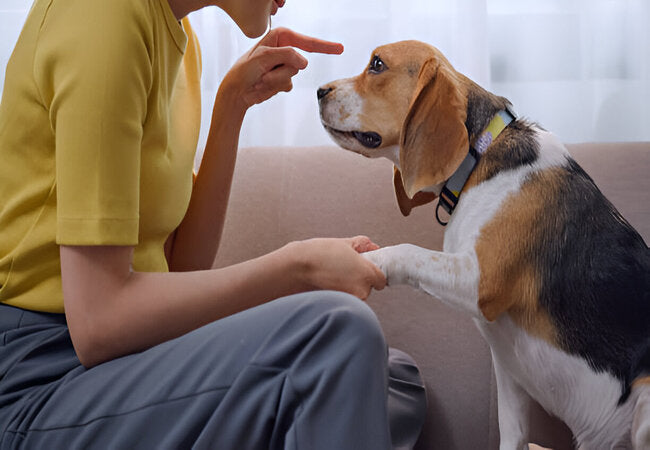How to Desensitize Your Pet to Triggers — Vet Guide 2025 ✅🐾

In this article
How to Desensitize Your Pet to Triggers—Vet Guide 2025 🐾
By Dr. Duncan Houston BVSc
Many pets react fearfully to things like vet visits, fireworks, vacuum cleaners, or strangers. In 2025, veterinarians use desensitization and counter-conditioning—science-based, reward-driven methods—to help pets feel calm around these triggers. This process reshapes their emotional response, creating lasting confidence through repeat, positive experiences.
1. Understanding the Techniques 🧠
Desensitization means gently and repeatedly exposing your pet to a low-level version of the trigger—just below the threshold where fear occurs—and slowly increasing intensity once they’re relaxed.
Counter-conditioning pairs the trigger with something your pet loves—like treats or play—so they learn, “Oh, that thing means good stuff is coming!”.
2. Step-by-Step Desensitization Process
- Identify triggers: noises, sights, handling, vet visits.
- Create a baseline: Observe at what distance or volume your pet stays calm.
- Start low: Present the faintest version—distant sound, hidden vacuum, gentle touch—alongside rewards.
- Gradually increase: Move closer or raise volume only when your pet remains relaxed.
- Use clear signals: Mark calm behavior with a click or word, then reward immediately.
- Track progress: Keep a journal noting distance/volume levels, body language, and rewards used.
3. Use the Engage–Disengage Game
This method builds thresholds for reactive dogs:
- Engage: At a safe distance, the moment your dog notices the trigger—say “click” and treat.
- Disengage: As soon as they look away or relax, reward again and increase distance.
- Repeat short sessions (1–5 minutes), resting between, building little by little every day.
4. Veterinary Visits: A Common Use Case
Vet visits are a top stressor. Here’s how to help:
- Handling at home: Gently touch paws, ears, muzzle—pair with treats—so exams feel normal.
- Friendly practice visits: Drop by the vet’s lobby, let them sniff and get treats without any procedure.
- Calm environment: Go during quiet times, bring towels, play soft music or white noise.
- Small exam steps: Reward after each stage—standing on the table, ear touch, nail trim, injection—before moving on.
- Consider mild sedation: For highly anxious pets, pre-visit medication may ease stress while training continues.
5. At-Home Practice Strategies
- Sound file training: Play low-volume recordings of noises (thunder, vacuum); treat when they stay calm.
- Toy-based exposure: Gradually introduce parts of appliances while ensuring your dog remains relaxed.
- Positive handling: Regular ear, paw, tail, and muzzle touch-ups paired with treats help reinforce calm during vet exams.
- Ensure routine: Practice short, daily sessions to build resilience over time.
6. Managing Challenging Moments
- If your pet shows fear—yawning, lip-licking, averting gaze—stop and move back a step.
- Always stay below the pet’s threshold to avoid making things worse.
- Consistency is key—small, repeated wins build lasting confidence.
- Complete with reward every time they succeed, even partially—the open-bar approach.
7. When to Seek Professional Help
If progress stalls or fear remains intense, a veterinary behaviorist or certified trainer can craft a customized plan—often including desensitization, counter-conditioning, enrichment, and sometimes medication.
8. 2025 Owner Action Plan 📋
- 👉 Identify your pet’s triggers and fear threshold.
- 🧩 Build gradual, reward-based exposures at home.
- 🎯 Use clicker or marker words to reinforce calm.
- 🎵 Add soothing environmental aids—white noise, pheromones, Thundershirts.
- 🏥 Practice happy vet visits with no procedures, just treats.
- 📊 Track small wins daily and adjust pace accordingly.
- 📞 Get behavioral support if needed—you're not alone.
FAQs 💬
• How long does this process take?
Weeks to months—depending on the trigger, your pet’s sensitivity, and consistency.
• What if we regress after progress?
Fear responses can resurface under stress. Return to a lower level and build again calmly.
• Can this help with separation anxiety?
Yes—gradual alone-time training combined with positive cues helps your pet learn comfort in your absence.
• Should I punish fearful behavior?
No—punishment increases anxiety. Reward calm behavior and remove triggers gently instead.
Conclusion ❤️
Desensitization and counter-conditioning offer gentle, science-based ways to help your pet feel confident instead of fearful. In 2025, with patience, consistency, and support from Ask A Vet, Woopf, and Purrz, you can transform anxiety triggers into calm, trusting experiences—one safe step at a time. 🐕✨
Need guidance? Visit AskAVet.com or download the Ask A Vet app for caring, expert support anytime.






